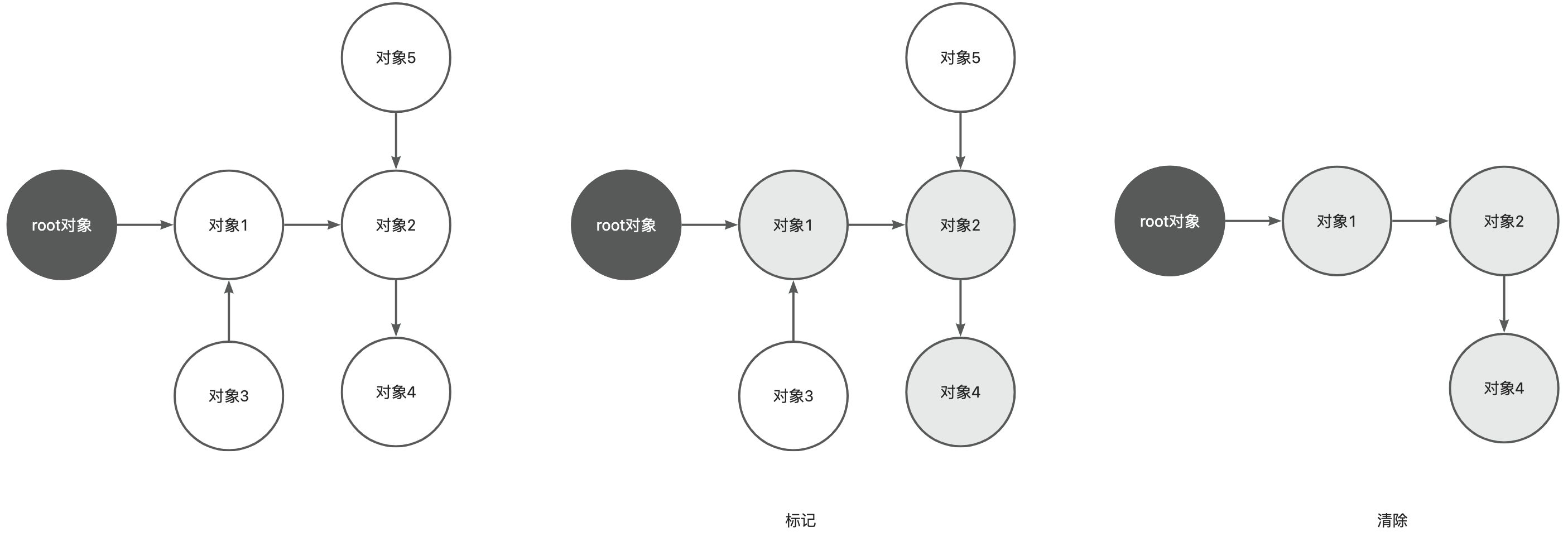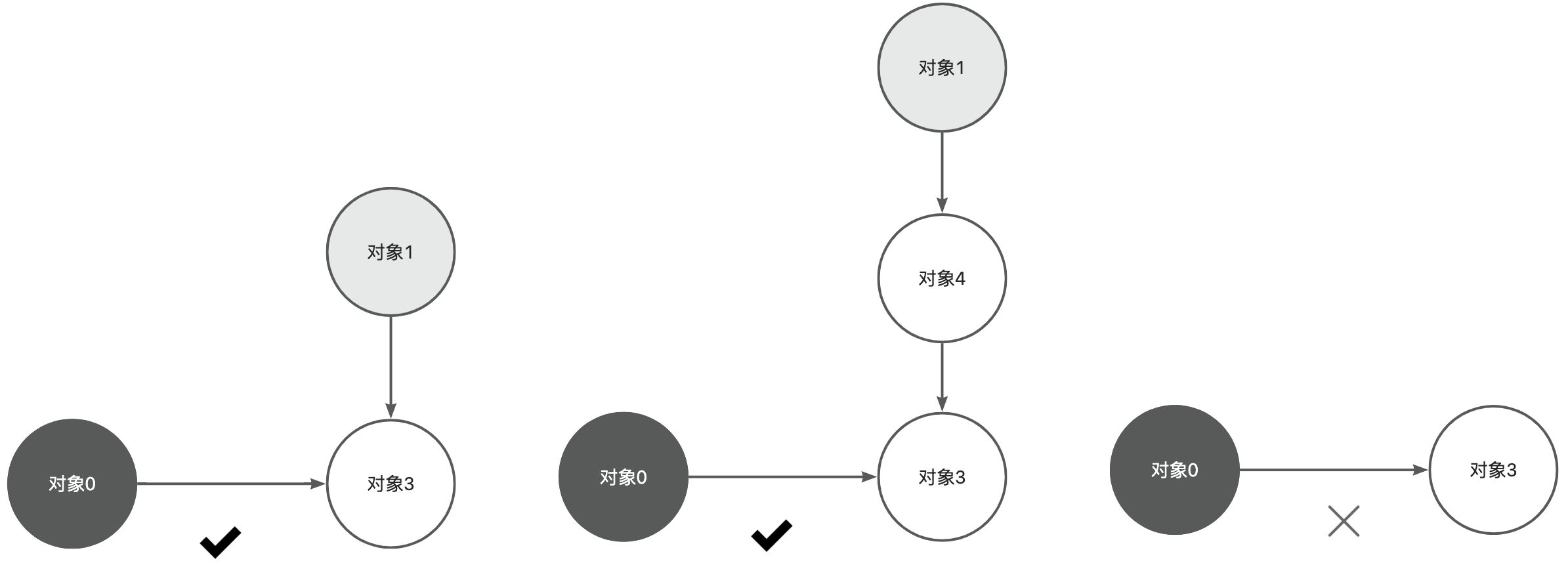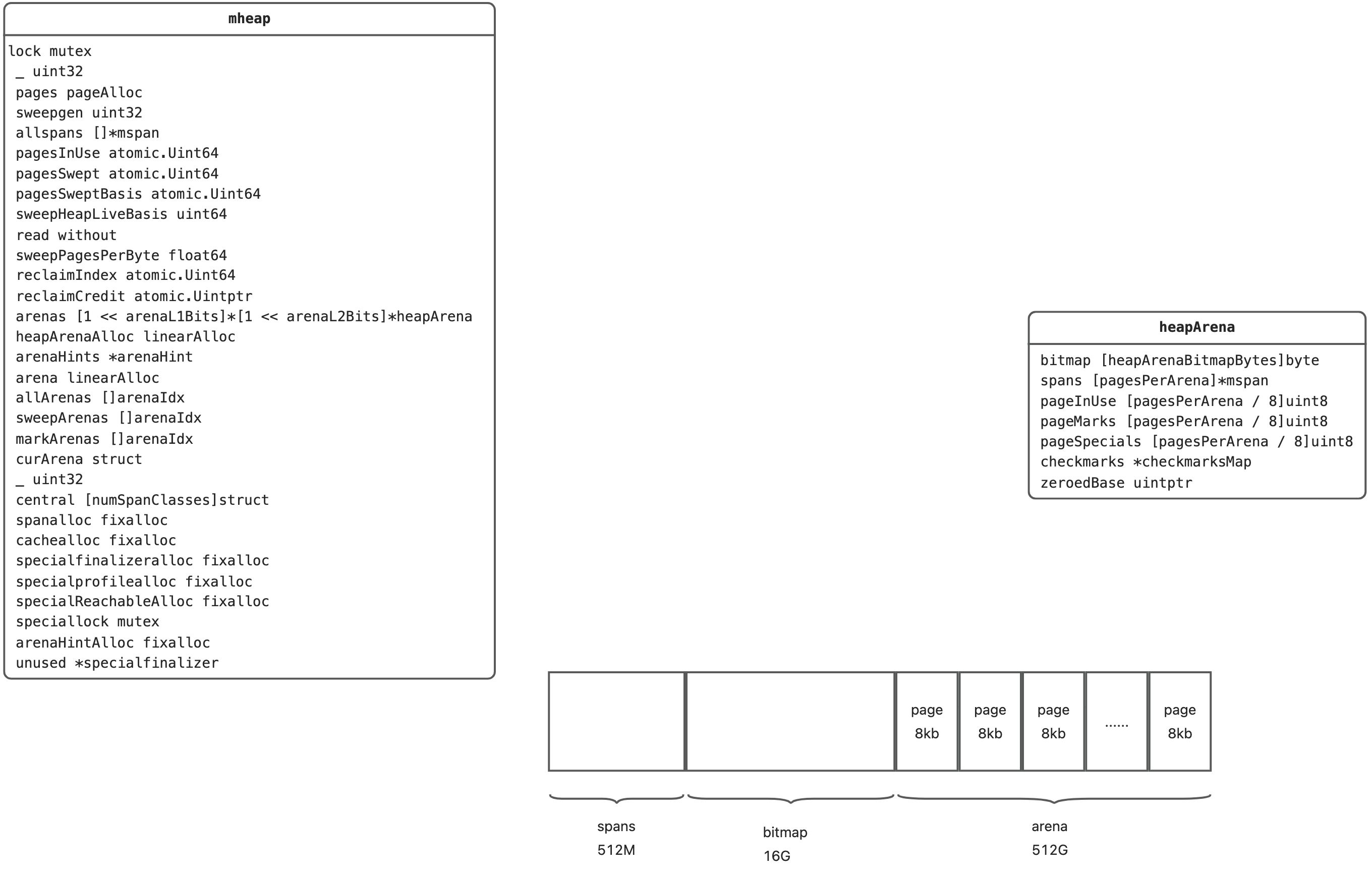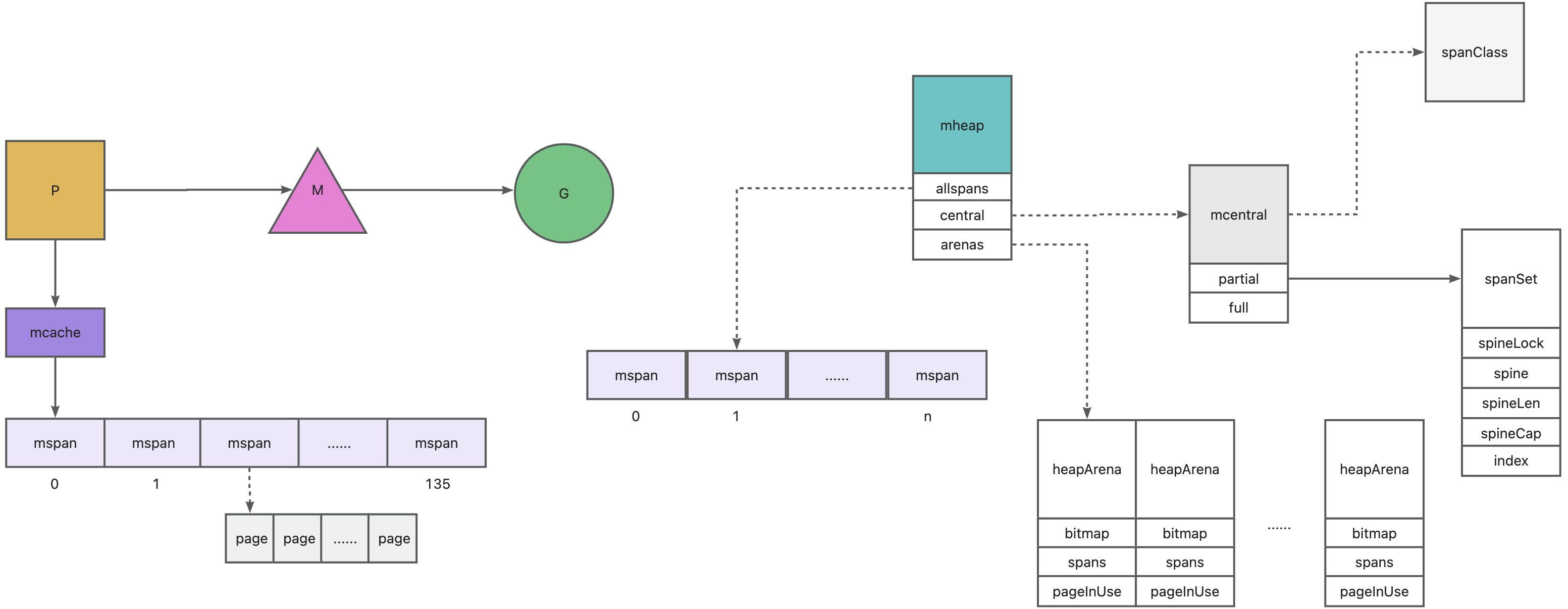Golang篇-Golang学习笔记

本篇主要记录学习Golang过程的笔记
简介
Go语言(或 Golang)起源于 2007 年,并在 2009 年正式对外发布。Go 是非常年轻的一门语言,它的主要目标是“兼具 Python 等动态语言的开发速度和 C/C++ 等编译型语言的性能与安全性”。
Go语言是编程语言设计的又一次尝试,是对类C语言的重大改进,它不但能让你访问底层操作系统,还提供了强大的网络编程和并发编程支持。Go语言的用途众多,可以进行网络编程、系统编程、并发编程、分布式编程。
Go语言的推出,旨在不损失应用程序性能的情况下降低代码的复杂性,具有“部署简单、并发性好、语言设计良好、执行性能好”等优势,目前国内诸多 IT 公司均已采用Go语言开发项目。
Go语言有时候被描述为“C 类似语言”,或者是“21 世纪的C语言”。Go 从C语言继承了相似的表达式语法、控制流结构、基础数据类型、调用参数传值、指针等很多思想,还有C语言一直所看中的编译后机器码的运行效率以及和现有操作系统的无缝适配。
因为Go语言没有类和继承的概念,所以它和 Java 或 C++ 看起来并不相同。但是它通过接口(interface)的概念来实现多态性。Go语言有一个清晰易懂的轻量级类型系统,在类型之间也没有层级之说。因此可以说Go语言是一门混合型的语言。
此外,很多重要的开源项目都是使用Go语言开发的,其中包括 Docker、Go-Ethereum、Thrraform 和 Kubernetes。
安装
1.下载安装包
2.查看版本
1 | |
语法
关键字
| break | 常用于跳出循环,switch | default | 配合switch、select | func | 定义函数 | interface | 接口 | select | 选择流程 |
|---|---|---|---|---|---|---|---|---|---|
| case | 配合switch | defer | 后置处理 | go | 并行 | map | 字典 | struct | 结构体 |
| chan | 管道 | else | 否则 | goto | 跳到某个代码块 | package | 包 | switch | 分支 |
| const | 常量 | fallthrough | 搭配switch | if | 判断 | range | 范围 | type | 类型声明 |
| continue | 结束一次循环 | for | 循环 | import | 导包 | return | 返回 | var | 定义变量 |
基本类型
Go语言的基本类型有:
- bool
- string
- int、int8、int16、int32、int64
- uint、uint8、uint16、uint32、uint64、uintptr
- byte // uint8 的别名
- rune // int32 的别名 代表一个 Unicode 码
- float32、float64
- complex64、complex128(复数)
| 整数类型 | 备注 | |
|---|---|---|
有符号 | int | 所占用的字节数与运行机器的CPU相关。在32位机器中,大小为4字节;在64位机器中,大小为8字节 |
| | int8 | 占用一个字节存储(8位),范围是-128 ~ 127 |
| | int16 | 占用两个字节存储(16位),范围是-32768 ~ 32767 |
| | int32 | 占用四个字节存储(32位),范围是-2147483648 ~ 2147483647 |
| | int64 | 占用八个字节存储(64位),范围是-9223372036854775808 ~ 9223372036854775807 |
|
无符号 | uint | 所占用的字节数与运行机器的CPU相关。在32位机器中,大小为4字节;在64位机器中,大小为8字节 |
| | uint8 | 占用一个字节存储(即8位),范围是0 ~ 255 |
| | uint16 | 占用两个字节存储(16位),范围是0 ~ 65535 |
| | uint32 | 占用四个字节存储(32位),范围是0 ~ 4294967295 |
| | uint64 | 占用八个字节存储(64位),范围是0 ~ 18446744073709551615 |
| | uintptr | 一个无符号整数类型 |
| | byte | byte类型是uint8的别名 |
命名规范
在go中是区分大小写的,属性首字母大写表示公开,小写表示私有
变量声明
变量的命名规则遵循骆驼命名法,即首个单词小写,每个新单词的首字母大写
1 | |
1 | |
1 | |
函数声明

1 | |
变量赋值
1 | |
变量交换
1 | |
匿名变量
在golang中_表示空白标识符
1 | |
类型转换
1 | |
指针类型
1.创建指针
1 | |
逃逸分析
todo
定义常量
1 | |
类型别名
1 | |
注释使用
1 | |
godoc 工具
1 | |
1 | |
依赖管理
go使用的是go mod进行依赖管理
Modules 是相关 Go 包的集合,是源代码交换和版本控制的单元。Go语言命令直接支持使用 Modules,包括记录和解析对其他模块的依赖性,Modules 替换旧的基于 GOPATH 的方法,来指定使用哪些源文件。
开启
1 | |
详解
1 | |
分配内存

流程控制
分支语句(if 和 switch)、循环(for)和跳转(goto)语句。另外,还有循环控制语句(break 和 continue),前者的功能是中断循环或者跳出 switch 判断,后者的功能是继续 for 的下一个循环
1 | |
1 | |
函数
1.函数定义
1 | |
1 | |
2.函数返回值
1 | |
3.函数也可以作为参数传递
1 | |
4.带有变量名的返回值
1 | |
5.函数变量
1 | |
6.匿名函数
1 | |
1 | |
1 | |
参数
1.可变参数
1 | |
闭包
函数 + 引用环境 = 闭包
闭包(Closure)在某些编程语言中也被称为 Lambda 表达式。
定义:在函数内部引用了函数内部变量的函数
闭包内修改变量
1 | |
闭包的记忆
1 | |
defer其实也是一种闭包
后置
defer关键字作为函数的后置执行,在return之前执行,主要用于释放资源
1 | |
异常
Error
1 | |
自定义错误
1 | |
Panic
panic手动触发宕机,让程序崩溃,这样开发者可以及时地发现错误
1 | |
Recover
让进入宕机流程中的 goroutine 恢复过来,recover 仅在延迟函数 defer 中有效,在正常的执行过程中,调用 recover 会返回 nil 并且没有其他任何效果,如果当前的 goroutine 陷入错误,调用 recover 可以捕获到 panic 的输入值,并且恢复正常的执行。
1 | |
结构
结构体
定义
1 | |
案例
1 | |
实例化
1.实例化结构体类型
1 | |
案例
1 | |
2.创建指针类型
1 | |
案例
1 | |
3.取结构体地址实例化
1 | |
构造函数
1 | |
匿名属性
1 | |
容器
数组
1 | |
1 | |
切片
Go 语言切片是对数组的抽象(基于数组)。
Go 数组的长度不可改变,在特定场景中这样的集合就不太适用,Go 中提供了一种灵活,功能强悍的内置类型切片(“动态数组”),与数组相比切片的长度是不固定的,可以追加元素,在追加时可能使切片的容量增大。
1 | |
追加切片
1 | |
切片复制
1 | |
删除切片
1 | |
Map
1 | |
1 | |
判断是否存在
1 | |
删除
1 | |
并发map sync.Map
1 | |
列表
1 | |
排序
golang 的sort包下提供一些排序的api提供给开发者使用
1.简单排序
1 | |
2.自定义排序
1 | |
案例
包
在golang中的所有源文件都必须有所归属的包
概念
Go语言的包借助了目录树的组织形式,一般包的名称就是其源文件所在目录的名称,虽然Go语言没有强制要求包名必须和其所在的目录名同名,但还是建议包名和所在目录同名,这样结构更清晰。
定义
1 | |
只有在main包下的源文件才能独立运行
导包
1 | |
工具
go mod
1 | |
govendor
已废弃
地址:github.com/kardianos/govendor
常用
1) fmt
fmt 包实现了格式化的标准输入输出,这与C语言中的 printf 和 scanf 类似。其中的 fmt.Printf() 和 fmt.Println() 是开发者使用最为频繁的函数。
格式化短语派生于C语言,一些短语(%- 序列)是这样使用:
- %v:默认格式的值。当打印结构时,加号(%+v)会增加字段名;
- %#v:Go样式的值表达;
- %T:带有类型的 Go 样式的值表达。
1 | |
2) io
这个包提供了原始的 I/O 操作界面。它主要的任务是对 os 包这样的原始的 I/O 进行封装,增加一些其他相关,使其具有抽象功能用在公共的接口上。
3) bufio
bufio 包通过对 io 包的封装,提供了数据缓冲功能,能够一定程度减少大块数据读写带来的开销。
在 bufio 各个组件内部都维护了一个缓冲区,数据读写操作都直接通过缓存区进行。当发起一次读写操作时,会首先尝试从缓冲区获取数据,只有当缓冲区没有数据时,才会从数据源获取数据更新缓冲。
4) sort
sort 包提供了用于对切片和用户定义的集合进行排序的功能。
5) strconv
strconv 包提供了将字符串转换成基本数据类型,或者从基本数据类型转换为字符串的功能。
6) os
os 包提供了不依赖平台的操作系统函数接口,设计像 Unix 风格,但错误处理是 go 风格,当 os 包使用时,如果失败后返回错误类型而不是错误数量。
7) sync
sync 包实现多线程中锁机制以及其他同步互斥机制。
8) flag
flag 包提供命令行参数的规则定义和传入参数解析的功能。绝大部分的命令行程序都需要用到这个包。
9) encoding/json
JSON 目前广泛用做网络程序中的通信格式。encoding/json 包提供了对 JSON 的基本支持,比如从一个对象序列化为 JSON 字符串,或者从 JSON 字符串反序列化出一个具体的对象等。
10) html/template
主要实现了 web 开发中生成 html 的 template 的一些函数。
11) net/http
net/http 包提供 HTTP 相关服务,主要包括 http 请求、响应和 URL 的解析,以及基本的 http 客户端和扩展的 http 服务。
通过 net/http 包,只需要数行代码,即可实现一个爬虫或者一个 Web 服务器,这在传统语言中是无法想象的。
12) reflect
reflect 包实现了运行时反射,允许程序通过抽象类型操作对象。通常用于处理静态类型 interface{} 的值,并且通过 Typeof 解析出其动态类型信息,通常会返回一个有接口类型 Type 的对象。
13) os/exec
os/exec 包提供了执行自定义 linux 命令的相关实现。
14) strings
strings 包主要是处理字符串的一些函数集合,包括合并、查找、分割、比较、后缀检查、索引、大小写处理等等。
strings 包与 bytes 包的函数接口功能基本一致。
15) regexp
regexp包为正则表达式提供了官方支持,其采用 RE2 语法,除了\c、\C外,Go语言和 Perl、Python 等语言的正则基本一致。
16) bytes
bytes 包提供了对字节切片进行读写操作的一系列函数。字节切片处理的函数比较多,分为基本处理函数、比较函数、后缀检查函数、索引函数、分割函数、大小写处理函数和子切片处理函数等。
17) log
log 包主要用于在程序中输出日志。
log 包中提供了三类日志输出接口,Print、Fatal 和 Panic。
- Print 是普通输出;
- Fatal 是在执行完 Print 后,执行 os.Exit(1);
- Panic 是在执行完 Print 后调用 panic() 方法。
18) time
time包为时间相关api包
1 | |
19) context
接口
定义
1 | |
实例
1 | |
实现
1 | |
案例
1 | |
类型转换
Go语言中使用接口断言(type assertions)将接口转换成另外一个接口,也可以将接口转换为另外的类型
1 | |
其中,i 代表接口变量,T 代表转换的目标类型,t 代表转换后的变量。
案例
1 | |
关于接口的实现
- 如果定义的是 (Type)Method,则该类型会隐式的声明一个 (*Type)Method;
- 如果定义的是 (*Type)Method ,则不会隐式什么一个 (Type)Method。
如果接收者是指针类型,在函数内修改接收者是直接修改原始的变量的,如果是结构体类型因为传递的值拷贝,修改不会影响原始对象。
并发
golang
协程
goroutine 是一种非常轻量级的实现,可在单个进程里执行成千上万的并发任务,它是Go语言并发设计的核心。
开启协程
1 | |
案例
Channel
Channel 是 Golang 在语言级别提供的 goroutine 之间的通信方式,可以使用 channel 在两个或多个 goroutine 之间传递消息。Channel 是进程内的通信方式,因此通过 channel 传递对象的过程和调用函数时的参数传递行为比较一致,比如也可以传递指针等。使用通道发送和接收所需的共享资源,可以在 goroutine 之间消除竞争条件。
当一个资源需要在 goroutine 之间共享时,channel 在 goroutine 之间架起了一个管道,并提供了确保同步交换数据的机制。Channel 是类型相关的,也就是说,一个 channel 只能传递一种类型的值,这个类型需要在声明 channel 时指定。可以通过 channel 共享内置类型、命名类型、结构类型和引用类型的值或者指针。
结构

定义
1 | |
案例
1 | |
操作
关闭channel
1 | |
buffered channel
Go语言中有缓冲的通道(buffered channel)是一种在被接收前能存储一个或者多个值的通道。这种类型的通道并不强制要求 goroutine 之间必须同时完成发送和接收。通道会阻塞发送和接收动作的条件也会不同。只有在通道中没有要接收的值时,接收动作才会阻塞。只有在通道没有可用缓冲区容纳被发送的值时,发送动作才会阻塞。
注意:如果在main线程中直接对无缓冲区chan操作时,会产生deadlock
1 | |
案例
1 | |
unbuffered channel
无缓冲区是指在接收前没有能力保存任何值的通道。这种类型的通道要求发送 goroutine 和接收 goroutine 同时准备好,才能完成发送和接收操作。
1 | |
遍历chan
1 | |
1 | |
源码
1 | |
Context
又称上下文,golang 的 Context 包,是专门用来简化多个goroutine 之间传递数据、超时时间(deadline)、取消信号(cancellation signals)或者其他请求相关的信息
比如有一个网络请求Request,每个Request都需要开启一个goroutine做一些事情,这些goroutine又可能会开启其他的goroutine。这样的话, 我们就可以通过Context,来跟踪这些goroutine,并且通过Context来控制他们的目的
1 | |
- Deadline方法是获取设置的截止时间的意思,第一个返回式是截止时间,到了这个时间点,Context会自动发起取消请求;第二个返回值ok==false时表示没有设置截止时间,如果需要取消的话,需要调用取消函数进行取消。
- Done方法返回一个只读的chan,类型为struct{},我们在goroutine中,如果该方法返回的chan可以读取,则意味着parent context已经发起了取消请求,我们通过Done方法收到这个信号后,就应该做清理操作,然后退出goroutine,释放资源。之后,Err 方法会返回一个错误,告知为什么 Context 被取消。
- Err方法返回取消的错误原因,因为什么Context被取消。
- Value方法获取该Context上绑定的值,是一个键值对,所以要通过一个Key才可以获取对应的值,这个值一般是线程安全的。
通过根Context派生出子Context
1 | |
1 | |
1 | |
1 | |
1 | |
Select
select是go提供类似io多路复用的功能,有的类似Switch语句
特点
- 监听的case中,没有满足条件的就阻塞
- 多个满足条件的就任选一个执行
- select本身不带循环,需要外层的for
- default通常不用,会产生忙轮询
- break只能跳出select中的一个case简单案例
1
2
3
4
5
6
7
8
9//select基本用法
select {
case <- chan1:
// 如果chan1成功读到数据,则进行该case处理语句
case chan2 <- 1:
// 如果成功向chan2写入数据,则进行该case处理语句
default:
// 如果上面都没有成功,则进入default处理流程
}应用场景1
2
3
4
5
6
7
8
9
10
11
12
13
14
15
16
17
18
19
20
21
22
23
24
25
26
27func main9() {
ch := make(chan int)
go func() {
for {
select {
case v := <-ch:
fmt.Println("向ch读取数据:", v)
case ch <- 0:
fmt.Println("向ch写入数据")
}
}
}()
go func() {
for i := 0; i < 10; i++ {
ch <- i
fmt.Println("W")
time.Sleep(time.Second * 2)
}
}()
go func() {
for i := 0; i < 10; i++ {
<-ch
time.Sleep(time.Second * 2)
}
}()
time.Sleep(100 * time.Second)
}
锁 Lock
sync包下提供多种锁支持
Mutex�锁
1 | |
RWMutex锁
读写锁
1 | |
WaitGroup
类似于阻塞队列
1 | |
案例
1 | |
GOMAXPROCS
调整并发的运行性能
1 | |
查询
1 | |
反射
反射用于获取程序运行时的一些动态数据,解决golang是静态语言缺失动态性的问题,golang的反射相关api位于 reflect� 包下
案例
1 | |
I/O
golang的bufio 包中,实现了对数据 I/O 接口的缓冲功能
1 | |
文件
Go语言的 os 包下有一个 OpenFile 函数,其原型如下所示:
1 | |
其中 name 是文件的文件名,如果不是在当前路径下运行需要加上具体路径;flag 是文件的处理参数,为 int 类型,根据系统的不同具体值可能有所不同,但是作用是相同的。
下面列举了一些常用的 flag 文件处理参数:
- O_RDONLY:只读模式打开文件;
- O_WRONLY:只写模式打开文件;
- O_RDWR:读写模式打开文件;
- O_APPEND:写操作时将数据附加到文件尾部(追加);
- O_CREATE:如果不存在将创建一个新文件;
- O_EXCL:和 O_CREATE 配合使用,文件必须不存在,否则返回一个错误;
- O_SYNC:当进行一系列写操作时,每次都要等待上次的 I/O 操作完成再进行;
- O_TRUNC:如果可能,在打开时清空文件。
文本操作
1 | |
二进制操作
1 | |
压缩包操作
测试

单元测试
业务类
1 | |
测试类(注意类名:_test)
1 | |
性能测试
1 | |
1 | |
1 | |
响应结果
1 | |
覆盖率测试
测试覆盖率是指当运行测试用例时,代码(类,包,模块)中有多少被执行到。覆盖率通常用百分比来表示。例如当我们说一个包的覆盖率是85%的时候,就是说测试用例让包中85%的代码都运行过了。
1 | |
1 | |
响应结果
1 | |
帮助文档
1 | |
断言
在Go语言中类型断言的语法格式如下:
1 | |
其中,x 表示一个接口的类型,T 表示一个具体的类型(也可为接口类型)。
1 | |
案例
1 | |
打桩
打桩是一种在单元测试中替换外部依赖关系的技术。它允许您测试代码而不必使用实际的依赖项,例如数据库、网络服务等。
打桩通常是模拟依赖项的行为,例如返回预定义的数据或抛出特定的错误。这可以帮助测试代码的正确性,并且还可以使测试更快、更可靠。
使用打桩的好处是:
- 可以使用预定义的数据和错误进行测试,而不必使用真实的依赖项。
- 可以在测试中更好地控制依赖项的行为,以验证代码的正确性。
- 可以提高测试的速度和可靠性。
1
2
3
4
5
6
7
8
9
10
11
12
13
14
15
16
17
18
19
20
21
22
23
24
25
26
27
28
29
30
31
32
33
34
35
36
37
38package test
import (
"fmt"
"io/ioutil"
"net/http"
"strings"
"testing"
)
func TestGet(t *testing.T) {
// 设置打桩
http.DefaultClient.Transport = &stubTransport{}
resp, err := http.Get("https://www.baidu.com")
if err != nil {
t.Fatal(err)
}
defer resp.Body.Close()
body, err := ioutil.ReadAll(resp.Body)
if err != nil {
t.Fatal(err)
}
fmt.Println(string(body))
}
// 打桩实现
type stubTransport struct{}
func (t *stubTransport) RoundTrip(req *http.Request) (*http.Response, error) {
return &http.Response{
StatusCode: 200,
Body: ioutil.NopCloser(strings.NewReader("Hello, world!")),
}, nil
}1
2
3
4
5
6
7
8
9
10
11
12
13
14
15
16
17
18
19
20
21
22
23
24
25
26
27package test
import (
"fmt"
"testing"
)
type stubDB struct{}
func (db *stubDB) Get(key string) (string, error) {
return "value", nil
}
func GetData(db *stubDB, key string) (string, error) {
return db.Get(key)
}
func TestGetData(t *testing.T) {
// 设置打桩
db := &stubDB{}
data, err := GetData(db, "key")
if err != nil {
t.Fatal(err)
}
fmt.Println(data)
}
Mock
1 | |
相关mock库:https://github.com/golang/mock
Mock 和打桩在测试中是指用来替代实际对象的虚拟对象,用于在测试环境中达到测试目的。
打桩(stubbing)是指创建一个模拟对象,该对象返回固定的数据,这些数据在测试过程中是固定不变的。打桩主要用于模拟依赖项,在测试代码中为这些依赖项提供一组固定的数据,以保证测试代码在独立于其依赖项的情况下正常工作。
模拟(mocking)是指创建一个模拟对象,该对象可以根据测试需要提供不同的数据,以验证测试代码的正确性。模拟的目的是测试代码的行为,它允许您验证测试代码是否正确地使用了它的依赖项。
因此,打桩和模拟是测试中不同的技术,但它们都用于代替实际对象,以帮助开发人员在测试环境中测试代码。
日志
垃圾
垃圾回收
- Go1.3采用标记清除法。
- Go1.5采用三色标记法。
- Go1.8采用三色标记法+混合写屏障。
根对象:根对象是指赋值器不需要通过其他对象就可以直接访问到的对象,通过Root对象, 可以追踪到其他存活的对象。常见的root对象有:
- 全局变量:程序在编译期就能确定的那些存在于程序整个生命周期的变量。
- 执行栈:每个 goroutine (包括main函数)都拥有自己的执行栈,这些执行栈上包含栈上的变量及堆内存指针。(堆内存指针即在gorouine中申请或者引用了在堆内存的变量)
v1.3 标记清除法
分为两个阶段:标记和清除
标记阶段:从根对象出发寻找并标记所有存活的对象。
清除阶段:遍历堆中的对象,回收未标记的对象,并加入空闲链表。
缺点是整个过程都需要暂停程序STW。
因为如果不进行STW的话,会出现已经被标记的对象A,引用了新的未被标记的对象B,但由于对象A已经标记过了,不会再重新扫描A对B的可达性,从而将B对象当做垃圾回收掉。(白色对象引用黑色对象的情况)

v1.5 三色标记法
将对象标记为白色,灰色或黑色。
- 白色:不确定对象(默认色);
- 黑色:存活对象。
- 灰色:存活对象,子对象待处理。
标记开始时,先将所有对象加入白色集合(需要STW)。首先将根对象标记为灰色,然后将一个对象从灰色集合取出,遍历其子对象,放入灰色集合。同时将取出的对象放入黑色集合,直到灰色集合为空。最后的白色集合对象就是需要清理的对象。
这种方法有一个缺陷,如果对象的引用被用户修改了,那么之前的标记就无效了。因此Go采用了写屏障技术,当对象新增或者更新会将其着色为灰色。

上述的三色标记仍然需要stop the world,如果不STW在标记过程中,如对象6引用了对象5,由于对象6已经扫描过,不会再次扫描,此时对象5仍会被GC掉。
在三色标记法的过程中对象丢失,需要同时满足下面两个条件:
- 条件一:白色对象被黑色对象引用
- 条件二:灰色对象与白色对象之间的可达关系遭到破坏
看来只要把上面两个条件破坏掉一个,就可以保证对象不丢失,所以golang团队就提出了两种破坏条件的方式:强三色不变式和弱三色不变式。
强三色不变式
规则:不允许黑色对象引用白色对象
原理:如果一个黑色对象不直接引用白色对象,那么就不会出现白色对象扫描不到,从而被当做垃圾回收掉的情况。

弱三色不变式
规则:黑色对象可以引用白色对象,但是白色对象的上游必须存在灰色对象
原理: 如果一个白色对象的上游有灰色对象,则这个白色对象一定可以扫描到,从而不被回收。

基于上述两种不变式提到的原则,分别提出了两种实现机制:插入写屏障和删除写屏障。
插入写屏障
规则:当一个对象引用另外一个对象时,将另外一个对象标记为灰色。
满足:强三色不变式。不会存在黑色对象引用白色对象
插入写屏障只会发生在堆区,栈区的对象分配操作十分频繁,如果进行写屏障会有性能问题
由于栈上的对像没有插入写机制,在扫描完成后,仍然可能存在栈上的白色对象被黑色对象引用,所以在最后需要对栈上的空间进行STW,防止对象误删除。
写屏障最大的弊端就是,在一次正常的三色标记流程结束后,需要对栈上重新进行一次stw,然后再rescan一次。
删除写屏障
规则:在删除引用时,如果被删除引用的对象自身为灰色或者白色,那么被标记为灰色。满足弱三色不变式。灰色对象到白色对象的路径不会断
解释:白色对象始终会被灰色对象保护

删除写屏障的缺点是当我们对一个对象取消引用后,其没有任何引用也会存活到下一次GC,可能会堆积很多垃圾
1.5采用了插入写屏障
v1.8 三色标记法+混合写屏障
基于上述两种的写屏障的机制进行优化,取长补短,1.8采用了混合写屏障的方式来进行标记
GC刚开始的时候,会将栈上的可达对象全部标记为黑色。
GC期间,任何在栈上新创建的对象,均为黑色。
上面两点只有一个目的,将栈上的可达对象全部标黑,最后无需对栈进行STW,就可以保证栈上的对象不会丢失。有人说,一直是黑色的对象,那么不就永远清除不掉了么,这里强调一下,标记为黑色的是可达对象,不可达的对象一直会是白色,直到最后被回收。
堆上被删除的对象标记为灰色
堆上新添加的对象标记为灰色

混合写屏障,其屏障限制只在堆内存中生效,无需二次扫描栈,提升了GC效率
源码分析
1.隐式调用
go会通过独立的进程扫描已经不再使用的变量,进程gc
2.显式调用
1 | |
3.SetFinalizer
在对象被收集前会调用该对象配置的SetFinalizer
1 | |
Golang中垃圾回收支持三种模式:
(1)gcBackgroundMode,默认模式,标记与清扫过程都是并发执行的;
(2)gcForceMode,只在清扫阶段支持并发;
(3)gcForceBlockMode,GC全程需要STW。
1 | |
1.执行GC函数
src/runtime/mgc.go
1 | |
2.垃圾标记
1 | |
3.执行垃圾收集
1 | |
内存
Go语言的内存管理是基于TCMalloc (Thread-Caching Malloc) 模型设计的,TCMalloc是一种典型的分级、多链表内存管理模型,可以很好的应对碎片化内存。
内存组成组件
go实现了自己的内存分配器,维护一个大的全局内存,每个线程(Golang中为P)维护一个小的私有内存,私有内存不足再从全局申请。为了方便自主管理内存,做法便是先向系统申请一块内存,然后将内存切割成小块,通过一定的内存分配算法管理内存。以64位系统为例,Golang程序启动时会向系统申请的内存如下图所示:
预申请的内存划分为spans、bitmap、arena三部分。其中arena即为所谓的堆区,应用中需要的内存从这里分配。其中spans和bitmap是为了管理arena区而存在的。
- arena的大小为512G,为了方便管理把arena区域划分成一个个的page,每个page为8KB,一共有512GB/8KB个页;
- spans区域存放span的指针,每个指针对应一个page,所以span区域的大小为(512GB/8KB)*指针大小8byte = 512M
- bitmap区域大小也是通过arena计算出来,主要用于GC。
arean
spans
该内存区域主要存放内存管理单元mspan指针,每个指针对于1或N个page,512MB = 512GB/8KB(页大小)*8B(指针大小)
为了解决内存碎片化带了的分配问题(查找空闲内存时间复杂度增加),golang中划分出67种内存块(span),8b-32k范围,组成空闲链表,提高分配效率
- class: class ID,每个span结构中都有一个class ID, 表示该span可处理的对象类型
- bytes /obj:该class代表对象的字节数
- bytes/span:每个span占用堆的字节数,也即页数*页大小
- objects: 每个span可分配的对象个数,也即(bytes/spans)/(bytes/obj)
- waste bytes: 每个span产生的内存碎片,也即(bytes/spans)%(bytes/obj)
1
2
3
4
5
6
7
8
9
10
11
12
13
14
15
16
17
18
19
20
21
22
23
24
25
26
27
28
29
30
31
32
33
34
35
36
37
38
39
40
41
42
43
44
45
46
47
48
49
50
51
52
53
54
55
56
57
58
59
60
61
62
63
64
65
66
67
68
69
70
71
72
73
74
75
76
77
78
79
80
81
82
83
84
85
86
87
88
89
90
91
92// class bytes/obj bytes/span objects tail waste max waste min align
// 1 8 8192 1024 0 87.50% 8
// 2 16 8192 512 0 43.75% 16
// 3 24 8192 341 8 29.24% 8
// 4 32 8192 256 0 21.88% 32
// 5 48 8192 170 32 31.52% 16
// 6 64 8192 128 0 23.44% 64
// 7 80 8192 102 32 19.07% 16
// 8 96 8192 85 32 15.95% 32
// 9 112 8192 73 16 13.56% 16
// 10 128 8192 64 0 11.72% 128
// 11 144 8192 56 128 11.82% 16
// 12 160 8192 51 32 9.73% 32
// 13 176 8192 46 96 9.59% 16
// 14 192 8192 42 128 9.25% 64
// 15 208 8192 39 80 8.12% 16
// 16 224 8192 36 128 8.15% 32
// 17 240 8192 34 32 6.62% 16
// 18 256 8192 32 0 5.86% 256
// 19 288 8192 28 128 12.16% 32
// 20 320 8192 25 192 11.80% 64
// 21 352 8192 23 96 9.88% 32
// 22 384 8192 21 128 9.51% 128
// 23 416 8192 19 288 10.71% 32
// 24 448 8192 18 128 8.37% 64
// 25 480 8192 17 32 6.82% 32
// 26 512 8192 16 0 6.05% 512
// 27 576 8192 14 128 12.33% 64
// 28 640 8192 12 512 15.48% 128
// 29 704 8192 11 448 13.93% 64
// 30 768 8192 10 512 13.94% 256
// 31 896 8192 9 128 15.52% 128
// 32 1024 8192 8 0 12.40% 1024
// 33 1152 8192 7 128 12.41% 128
// 34 1280 8192 6 512 15.55% 256
// 35 1408 16384 11 896 14.00% 128
// 36 1536 8192 5 512 14.00% 512
// 37 1792 16384 9 256 15.57% 256
// 38 2048 8192 4 0 12.45% 2048
// 39 2304 16384 7 256 12.46% 256
// 40 2688 8192 3 128 15.59% 128
// 41 3072 24576 8 0 12.47% 1024
// 42 3200 16384 5 384 6.22% 128
// 43 3456 24576 7 384 8.83% 128
// 44 4096 8192 2 0 15.60% 4096
// 45 4864 24576 5 256 16.65% 256
// 46 5376 16384 3 256 10.92% 256
// 47 6144 24576 4 0 12.48% 2048
// 48 6528 32768 5 128 6.23% 128
// 49 6784 40960 6 256 4.36% 128
// 50 6912 49152 7 768 3.37% 256
// 51 8192 8192 1 0 15.61% 8192
// 52 9472 57344 6 512 14.28% 256
// 53 9728 49152 5 512 3.64% 512
// 54 10240 40960 4 0 4.99% 2048
// 55 10880 32768 3 128 6.24% 128
// 56 12288 24576 2 0 11.45% 4096
// 57 13568 40960 3 256 9.99% 256
// 58 14336 57344 4 0 5.35% 2048
// 59 16384 16384 1 0 12.49% 8192
// 60 18432 73728 4 0 11.11% 2048
// 61 19072 57344 3 128 3.57% 128
// 62 20480 40960 2 0 6.87% 4096
// 63 21760 65536 3 256 6.25% 256
// 64 24576 24576 1 0 11.45% 8192
// 65 27264 81920 3 128 10.00% 128
// 66 28672 57344 2 0 4.91% 4096
// 67 32768 32768 1 0 12.50% 8192
// alignment bits min obj size
// 8 3 8
// 16 4 32
// 32 5 256
// 64 6 512
// 128 7 768
// 4096 12 28672
// 8192 13 32768
const (
_MaxSmallSize = 32768
smallSizeDiv = 8
smallSizeMax = 1024
largeSizeDiv = 128
_NumSizeClasses = 68
_PageShift = 13
)
var class_to_size = [_NumSizeClasses]uint16{0, 8, 16, 24, 32, 48, 64, 80, 96, 112, 128, 144, 160, 176, 192, 208, 224, 240, 256, 288, 320, 352, 384, 416, 448, 480, 512, 576, 640, 704, 768, 896, 1024, 1152, 1280, 1408, 1536, 1792, 2048, 2304, 2688, 3072, 3200, 3456, 4096, 4864, 5376, 6144, 6528, 6784, 6912, 8192, 9472, 9728, 10240, 10880, 12288, 13568, 14336, 16384, 18432, 19072, 20480, 21760, 24576, 27264, 28672, 32768}
var class_to_allocnpages = [_NumSizeClasses]uint8{0, 1, 1, 1, 1, 1, 1, 1, 1, 1, 1, 1, 1, 1, 1, 1, 1, 1, 1, 1, 1, 1, 1, 1, 1, 1, 1, 1, 1, 1, 1, 1, 1, 1, 1, 2, 1, 2, 1, 2, 1, 3, 2, 3, 1, 3, 2, 3, 4, 5, 6, 1, 7, 6, 5, 4, 3, 5, 7, 2, 9, 7, 5, 8, 3, 10, 7, 4}
var class_to_divmagic = [_NumSizeClasses]uint32{0, ^uint32(0)/8 + 1, ^uint32(0)/16 + 1, ^uint32(0)/24 + 1, ^uint32(0)/32 + 1, ^uint32(0)/48 + 1, ^uint32(0)/64 + 1, ^uint32(0)/80 + 1, ^uint32(0)/96 + 1, ^uint32(0)/112 + 1, ^uint32(0)/128 + 1, ^uint32(0)/144 + 1, ^uint32(0)/160 + 1, ^uint32(0)/176 + 1, ^uint32(0)/192 + 1, ^uint32(0)/208 + 1, ^uint32(0)/224 + 1, ^uint32(0)/240 + 1, ^uint32(0)/256 + 1, ^uint32(0)/288 + 1, ^uint32(0)/320 + 1, ^uint32(0)/352 + 1, ^uint32(0)/384 + 1, ^uint32(0)/416 + 1, ^uint32(0)/448 + 1, ^uint32(0)/480 + 1, ^uint32(0)/512 + 1, ^uint32(0)/576 + 1, ^uint32(0)/640 + 1, ^uint32(0)/704 + 1, ^uint32(0)/768 + 1, ^uint32(0)/896 + 1, ^uint32(0)/1024 + 1, ^uint32(0)/1152 + 1, ^uint32(0)/1280 + 1, ^uint32(0)/1408 + 1, ^uint32(0)/1536 + 1, ^uint32(0)/1792 + 1, ^uint32(0)/2048 + 1, ^uint32(0)/2304 + 1, ^uint32(0)/2688 + 1, ^uint32(0)/3072 + 1, ^uint32(0)/3200 + 1, ^uint32(0)/3456 + 1, ^uint32(0)/4096 + 1, ^uint32(0)/4864 + 1, ^uint32(0)/5376 + 1, ^uint32(0)/6144 + 1, ^uint32(0)/6528 + 1, ^uint32(0)/6784 + 1, ^uint32(0)/6912 + 1, ^uint32(0)/8192 + 1, ^uint32(0)/9472 + 1, ^uint32(0)/9728 + 1, ^uint32(0)/10240 + 1, ^uint32(0)/10880 + 1, ^uint32(0)/12288 + 1, ^uint32(0)/13568 + 1, ^uint32(0)/14336 + 1, ^uint32(0)/16384 + 1, ^uint32(0)/18432 + 1, ^uint32(0)/19072 + 1, ^uint32(0)/20480 + 1, ^uint32(0)/21760 + 1, ^uint32(0)/24576 + 1, ^uint32(0)/27264 + 1, ^uint32(0)/28672 + 1, ^uint32(0)/32768 + 1}
var size_to_class8 = [smallSizeMax/smallSizeDiv + 1]uint8{0, 1, 2, 3, 4, 5, 5, 6, 6, 7, 7, 8, 8, 9, 9, 10, 10, 11, 11, 12, 12, 13, 13, 14, 14, 15, 15, 16, 16, 17, 17, 18, 18, 19, 19, 19, 19, 20, 20, 20, 20, 21, 21, 21, 21, 22, 22, 22, 22, 23, 23, 23, 23, 24, 24, 24, 24, 25, 25, 25, 25, 26, 26, 26, 26, 27, 27, 27, 27, 27, 27, 27, 27, 28, 28, 28, 28, 28, 28, 28, 28, 29, 29, 29, 29, 29, 29, 29, 29, 30, 30, 30, 30, 30, 30, 30, 30, 31, 31, 31, 31, 31, 31, 31, 31, 31, 31, 31, 31, 31, 31, 31, 31, 32, 32, 32, 32, 32, 32, 32, 32, 32, 32, 32, 32, 32, 32, 32, 32}
var size_to_class128 = [(_MaxSmallSize-smallSizeMax)/largeSizeDiv + 1]uint8{32, 33, 34, 35, 36, 37, 37, 38, 38, 39, 39, 40, 40, 40, 41, 41, 41, 42, 43, 43, 44, 44, 44, 44, 44, 45, 45, 45, 45, 45, 45, 46, 46, 46, 46, 47, 47, 47, 47, 47, 47, 48, 48, 48, 49, 49, 50, 51, 51, 51, 51, 51, 51, 51, 51, 51, 51, 52, 52, 52, 52, 52, 52, 52, 52, 52, 52, 53, 53, 54, 54, 54, 54, 55, 55, 55, 55, 55, 56, 56, 56, 56, 56, 56, 56, 56, 56, 56, 56, 57, 57, 57, 57, 57, 57, 57, 57, 57, 57, 58, 58, 58, 58, 58, 58, 59, 59, 59, 59, 59, 59, 59, 59, 59, 59, 59, 59, 59, 59, 59, 59, 60, 60, 60, 60, 60, 60, 60, 60, 60, 60, 60, 60, 60, 60, 60, 60, 61, 61, 61, 61, 61, 62, 62, 62, 62, 62, 62, 62, 62, 62, 62, 62, 63, 63, 63, 63, 63, 63, 63, 63, 63, 63, 64, 64, 64, 64, 64, 64, 64, 64, 64, 64, 64, 64, 64, 64, 64, 64, 64, 64, 64, 64, 64, 64, 65, 65, 65, 65, 65, 65, 65, 65, 65, 65, 65, 65, 65, 65, 65, 65, 65, 65, 65, 65, 65, 66, 66, 66, 66, 66, 66, 66, 66, 66, 66, 66, 67, 67, 67, 67, 67, 67, 67, 67, 67, 67, 67, 67, 67, 67, 67, 67, 67, 67, 67, 67, 67, 67, 67, 67, 67, 67, 67, 67, 67, 67, 67, 67}
bitmap
- 每个字节都会表示 arena 区域中的 32 字节是否空闲
- 主要用于gc
- 16G = 512GB/32B*1B
内存管理组件
go的内存管理组件主要有:mspan、mcache、mcentral和mheap、heapArena
- mspan:为内存管理的基础单元,直接存储数据的地方。
- mcache:每个运行期的goroutine都会绑定的一个mcache(具体来讲是绑定的GMP并发模型中的P,所以可以无锁分配mspan),mcache会分配goroutine运行中所需要的内存空间(即mspan)。
- mcentral:为所有mcache切分好后备的mspan
- mheap:代表Go程序持有的所有堆空间。还会管理闲置的span,需要时向操作系统申请新内存。

mcache
在GPM关系中,会在每个 P 下都有一个 mcache 字段,用来表示内存信息。在 Go 1.2 版本以前调度器使用的是 GM 模型,将 mcache 放在了 M 里,但发现存在诸多问题,其中对于内存这一块存在着巨大的浪费。每个 M 都持有 mcache 和 stack alloc,但只有在 M 运行 Go 代码时才需要使用内存(每个 mcache 可以高达2mb),当 M 在处于 syscall 或 网络请求 的时候是不需要内存的,再加上 M 又是允许创建多个的,这就造成了内存的很大浪费。所以从go 1.3版本开始使用了GPM模型,这样在高并发状态下,每个G只有在运行的时候才会使用到内存,而每个 G 会绑定一个P,所以它们在运行只占用一份 mcache,对于 mcache 的数量就是P 的数量,同时并发访问时也不会产生锁。
对于 GM 模型除了上面提供到内存浪费的问题,还有其它问题,如单一全局锁sched.Lock、goroutine 传递问题和内存局部性等。在 P 中,一个 mcache 除了可以用来缓存小对象外,还包含一些本地分配统计信息。由于在每个P下面都存在一个mcache ,所以多个 goroutine 并发请求内存时是无锁的。
在mcache中默认会有alloc� = 136个span空间提供给当前P使用
源码
src/runtime/mheap.go
1 | |
mspan
双向链表结构
mspan 是分配内存时的基本单元。当分配内存时,会在mcache中查找适合规格的可用 mspan,此时不需要加锁,因此分配效率极高。
如上面提到的,Go将内存块分为大小不同的 67 种,然后再把这 67 种大内存块,逐个分为小块(可以近似理解为大小不同的相当于page)称之为span(连续的page)
源码
src/runtime/mheap.go
1 | |
mcentral
两个包含/不包含空闲对象的mspan列表,mspan列表多线程共享,使用互斥锁保护
源码
src/runtime/mspanset.go
1 | |
1 | |
mheap
mheap即是我们说的堆区
1 | |
heapArena
g1.11版本以及之后引入二维稀疏内存
[l1][l2]heapArena
- Linux x86-64架构 l1=1 l2=4194304 32MB = 4194304*8B(指针大小) ,每个heapArena可以管理64MB内存
- 4M*64MB = 256TB内存
1
2
3
4
5
6
7
8
9
10
11
12
13
14
15
16
17
18
19
20
21
22
23
24
25
26
27
28
29
30
31
32
33
34
35
36
37
38
39
40
41
42
43
44
45
46
47
48
49
50
51
52
53
54
55
56
57
58
59
60
61
62
63
64
65
66
67
68
69
70
71
72
73
74
75// A heapArena stores metadata for a heap arena. heapArenas are stored
// outside of the Go heap and accessed via the mheap_.arenas index.
//
//go:notinheap
type heapArena struct {
// bitmap stores the pointer/scalar bitmap for the words in
// this arena. See mbitmap.go for a description. Use the
// heapBits type to access this.
bitmap [heapArenaBitmapBytes]byte
// 标记内内存是否使用
// spans maps from virtual address page ID within this arena to *mspan.
// For allocated spans, their pages map to the span itself.
// For free spans, only the lowest and highest pages map to the span itself.
// Internal pages map to an arbitrary span.
// For pages that have never been allocated, spans entries are nil.
//
// Modifications are protected by mheap.lock. Reads can be
// performed without locking, but ONLY from indexes that are
// known to contain in-use or stack spans. This means there
// must not be a safe-point between establishing that an
// address is live and looking it up in the spans array.
spans [pagesPerArena]*mspan
//对应的mspan管理器
// pageInUse is a bitmap that indicates which spans are in
// state mSpanInUse. This bitmap is indexed by page number,
// but only the bit corresponding to the first page in each
// span is used.
//
// Reads and writes are atomic.
pageInUse [pagesPerArena / 8]uint8
// pageMarks is a bitmap that indicates which spans have any
// marked objects on them. Like pageInUse, only the bit
// corresponding to the first page in each span is used.
//
// Writes are done atomically during marking. Reads are
// non-atomic and lock-free since they only occur during
// sweeping (and hence never race with writes).
//
// This is used to quickly find whole spans that can be freed.
//
// TODO(austin): It would be nice if this was uint64 for
// faster scanning, but we don't have 64-bit atomic bit
// operations.
pageMarks [pagesPerArena / 8]uint8
// pageSpecials is a bitmap that indicates which spans have
// specials (finalizers or other). Like pageInUse, only the bit
// corresponding to the first page in each span is used.
//
// Writes are done atomically whenever a special is added to
// a span and whenever the last special is removed from a span.
// Reads are done atomically to find spans containing specials
// during marking.
pageSpecials [pagesPerArena / 8]uint8
// checkmarks stores the debug.gccheckmark state. It is only
// used if debug.gccheckmark > 0.
checkmarks *checkmarksMap
// zeroedBase marks the first byte of the first page in this
// arena which hasn't been used yet and is therefore already
// zero. zeroedBase is relative to the arena base.
// Increases monotonically until it hits heapArenaBytes.
//
// This field is sufficient to determine if an allocation
// needs to be zeroed because the page allocator follows an
// address-ordered first-fit policy.
//
// Read atomically and written with an atomic CAS.
zeroedBase uintptr
//内存管理基地址
}
内存分配策略
总体过程
1.new,make最祭调用mallocac
2.大于32KB对象,直接从mheap中分配,构成一个span
3.小于16byte且无指针(noscan),使用tiny分配器,合并分配
4.小于16byte有指针或16byte-32KB,如果mcache中有对应class的空闲mspan,则直接从该mspan中分配一个slot.
5. (mcentral.cachespan) mcache没有对应的空余span,则从对应mcentral中申请一个有空余slot的span到mcache中再进行分配
6. ( mcentral.grow)对应mcentral没有空余span,则向(mheap(mheap_alloc)中申请一个span,能sweep出span则返回,否则看mheap的sfree mTreap能否分配最大于该size的连续页,能则分配,多的页放回
7.mheap的free mTreap无可用,则源用sysAlloc(mmap)向系统申请.
8.6,7步中获得的内存构进成span,返回给mcache,分配对象。
源码分析
src/runtime/malloc.go
1 | |
工具
1 | |
go build 命令
go clean 命令
go run 命令
go fmt 命令
go install 命令
go get 命令
go generate 命令
go test 命令
go pprof 命令
参考:https://www.yuque.com/aichihongdouheyumi/blog/serwt6h1lv6wlv86
go tool 命令
展示出go相关工具
- addr2line
- asm
- buildid
- cgo
compile
cover
- dist
- doc
- fix
- link
- nm
objdump 反编译工具
1
go tool objdump -S main.gopack
- pprof
- test2json
- trace
- vet
案例
创建项目
通过go mod来管理依赖和创建项目
1 | |
简单输出
1 | |
引入依赖
1 | |
下载失败配置代理
1 | |
计算函数运行时间
1 | |
规范
https://github.com/xxjwxc/uber_go_guide_cn
资料
安装:https://go.dev/doc/install
教程:http://c.biancheng.net/golang/
教程:https://pkg.go.dev/
